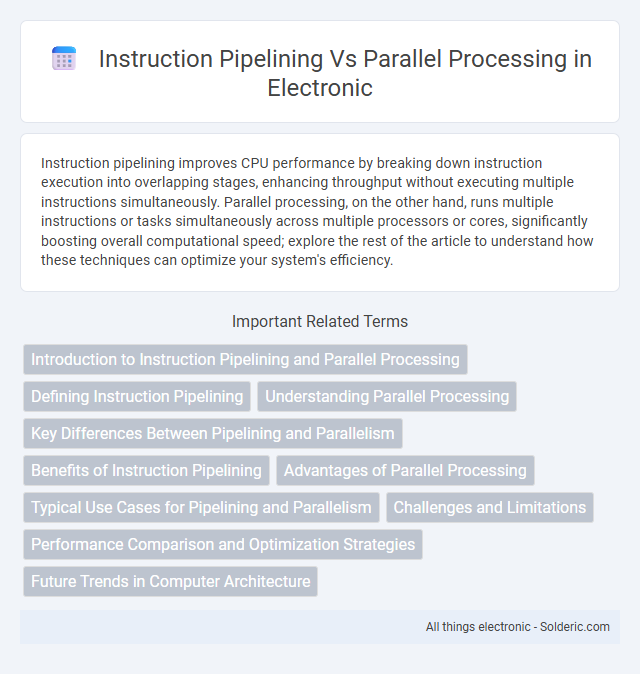Instruction pipelining improves CPU performance by breaking down instruction execution into overlapping stages, enhancing throughput without executing multiple instructions simultaneously. Parallel processing, on the other hand, runs multiple instructions or tasks simultaneously across multiple processors or cores, significantly boosting overall computational speed; explore the rest of the article to understand how these techniques can optimize your system's efficiency.
Comparison Table
| Aspect | Instruction Pipelining | Parallel Processing |
|---|---|---|
| Definition | Breaking an instruction into stages and processing them sequentially but overlapped | Executing multiple instructions or tasks simultaneously using multiple processors or cores |
| Objective | Increase instruction throughput by overlapping instruction phases | Increase overall computational speed by running tasks in parallel |
| Execution Model | Sequential with overlapped stages | True concurrent execution of multiple instructions or tasks |
| Hardware Requirements | Single processor with pipeline stages | Multiple processors or multi-core CPUs |
| Complexity | Moderate complexity due to hazards and stalls | High complexity with synchronization and communication overhead |
| Performance Gain | Improved instruction throughput, limited by pipeline hazards | Significant speedup proportional to number of processors |
| Example | Classic RISC pipeline (fetch, decode, execute, memory, write-back) | Multi-core processors running parallel threads |
Introduction to Instruction Pipelining and Parallel Processing
Instruction pipelining breaks down CPU tasks into sequential stages, enabling overlapping execution to improve instruction throughput and reduce latency. Parallel processing involves multiple processors or cores working simultaneously to execute separate instruction streams, significantly boosting computational speed and handling complex workloads efficiently. Your system's performance is enhanced by combining these techniques, leveraging both pipeline efficiency and multi-core concurrency.
Defining Instruction Pipelining
Instruction pipelining divides a processor's instruction cycle into separate stages, allowing multiple instructions to overlap execution efficiently. Each pipeline stage processes a different part of multiple instructions simultaneously, significantly improving throughput compared to sequential execution. Your CPU can execute instructions faster by reducing idle time within the processor's functional units.
Understanding Parallel Processing
Parallel processing divides tasks across multiple processors to execute simultaneously, significantly increasing computational speed and efficiency compared to instruction pipelining, which breaks a single instruction into stages executed sequentially. Your system benefits from parallel processing by handling multiple processes concurrently, reducing latency and improving throughput in data-intensive applications. This approach is essential in high-performance computing environments where maximizing resource utilization and minimizing execution time are critical.
Key Differences Between Pipelining and Parallelism
Instruction pipelining breaks down a single instruction into multiple stages, allowing overlapping execution within the same CPU core to improve throughput, while parallel processing executes multiple instructions or tasks simultaneously across multiple cores or processors. Pipelining increases instruction-level parallelism by sequentially organizing execution phases, whereas parallel processing enhances task-level parallelism by distributing workloads across multiple processing units. Your choice between the two depends on whether you're optimizing for single-thread efficiency or handling multiple threads concurrently.
Benefits of Instruction Pipelining
Instruction pipelining improves CPU throughput by allowing multiple instructions to overlap in execution stages, significantly speeding up processing efficiency. This method reduces instruction latency and maximizes resource utilization without requiring multiple processors, making it cost-effective for enhancing your system's performance. By breaking down instructions into discrete steps, pipelining enables continuous instruction flow, minimizing idle time in the CPU pipeline.
Advantages of Parallel Processing
Parallel processing significantly enhances computational speed by executing multiple instructions or tasks simultaneously across multiple processors or cores. It increases system throughput and efficiency, enabling complex problem-solving and large-scale data handling in fields such as scientific simulations, data analysis, and artificial intelligence. Parallel processing also improves fault tolerance and resource utilization by distributing workloads evenly and minimizing bottlenecks compared to instruction pipelining, which handles instructions sequentially within a single CPU core.
Typical Use Cases for Pipelining and Parallelism
Instruction pipelining is typically used in CPUs to increase instruction throughput by overlapping the execution stages of multiple instructions, ideal for sequential tasks such as arithmetic operations and basic control flow in general-purpose processors. Parallel processing excels in handling large-scale computations like scientific simulations, data mining, and video rendering by distributing tasks across multiple processors or cores to perform simultaneous execution. Both techniques enhance computational efficiency, with pipelining optimized for improving individual processor performance and parallelism suited for workloads requiring extensive concurrent processing.
Challenges and Limitations
Instruction pipelining faces challenges such as data hazards, control hazards, and pipeline stalls that reduce processor efficiency by causing delays. Parallel processing encounters limitations in task synchronization, inter-processor communication overhead, and workload imbalance, which can diminish scalability and overall system performance. Both approaches must address complexity in hardware design and software optimization to maximize throughput and minimize latency.
Performance Comparison and Optimization Strategies
Instruction pipelining improves CPU throughput by overlapping the execution phases of multiple instructions, enhancing instruction-level parallelism but is limited by hazards and pipeline stalls. Parallel processing leverages multiple processors or cores to execute tasks concurrently, offering superior performance gains for large-scale or independent workloads through task-level parallelism. Optimization strategies for pipelining involve hazard detection, branch prediction, and pipeline balancing, while parallel processing requires efficient load balancing, minimizing inter-process communication, and synchronization overhead.
Future Trends in Computer Architecture
Future trends in computer architecture emphasize enhanced instruction pipelining techniques combined with parallel processing to maximize throughput and reduce latency. Advanced pipeline designs, such as dynamic and speculative pipelining, work alongside multicore and manycore processors to exploit instruction-level and thread-level parallelism for improved computing efficiency. Innovations in heterogeneous architectures and AI-driven workload scheduling are poised to further blur the line between pipelining and parallelism, driving performance gains in next-generation systems.
instruction pipelining vs parallel processing Infographic

 solderic.com
solderic.com